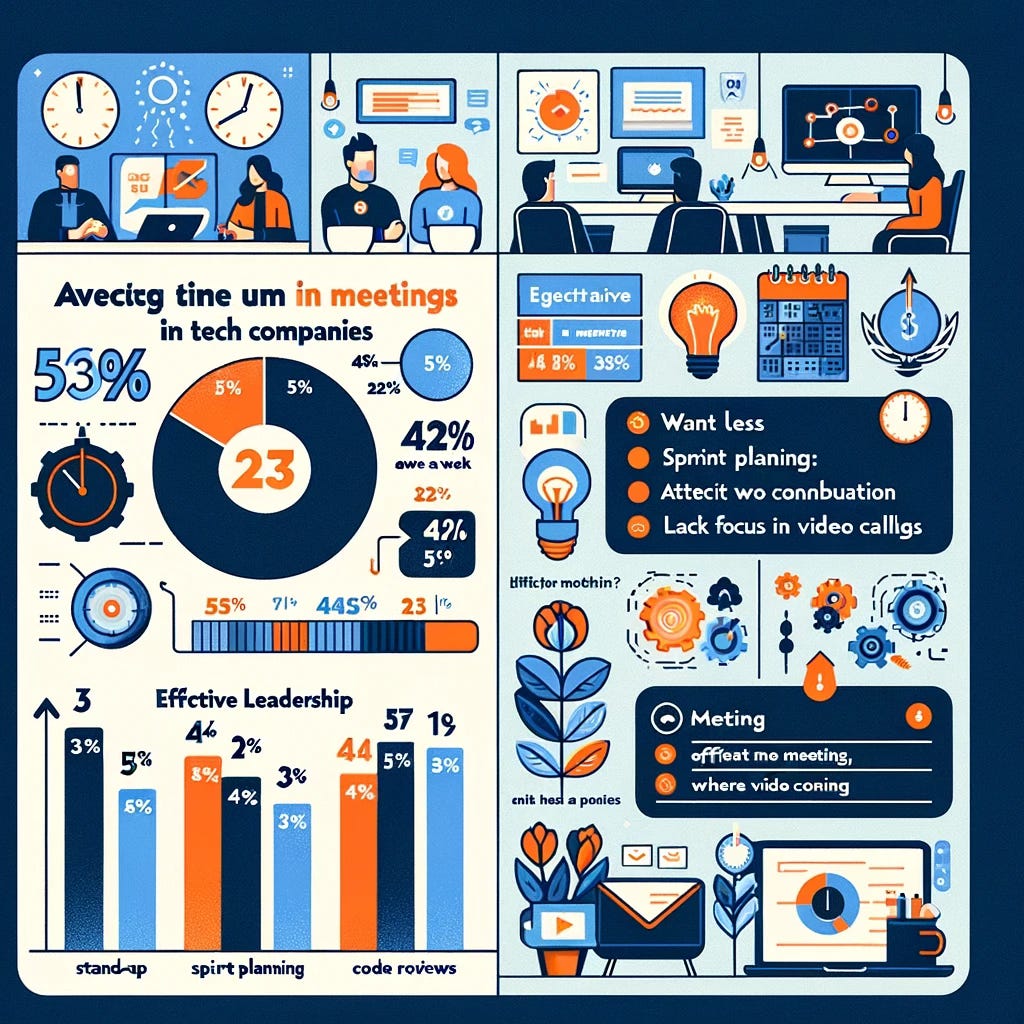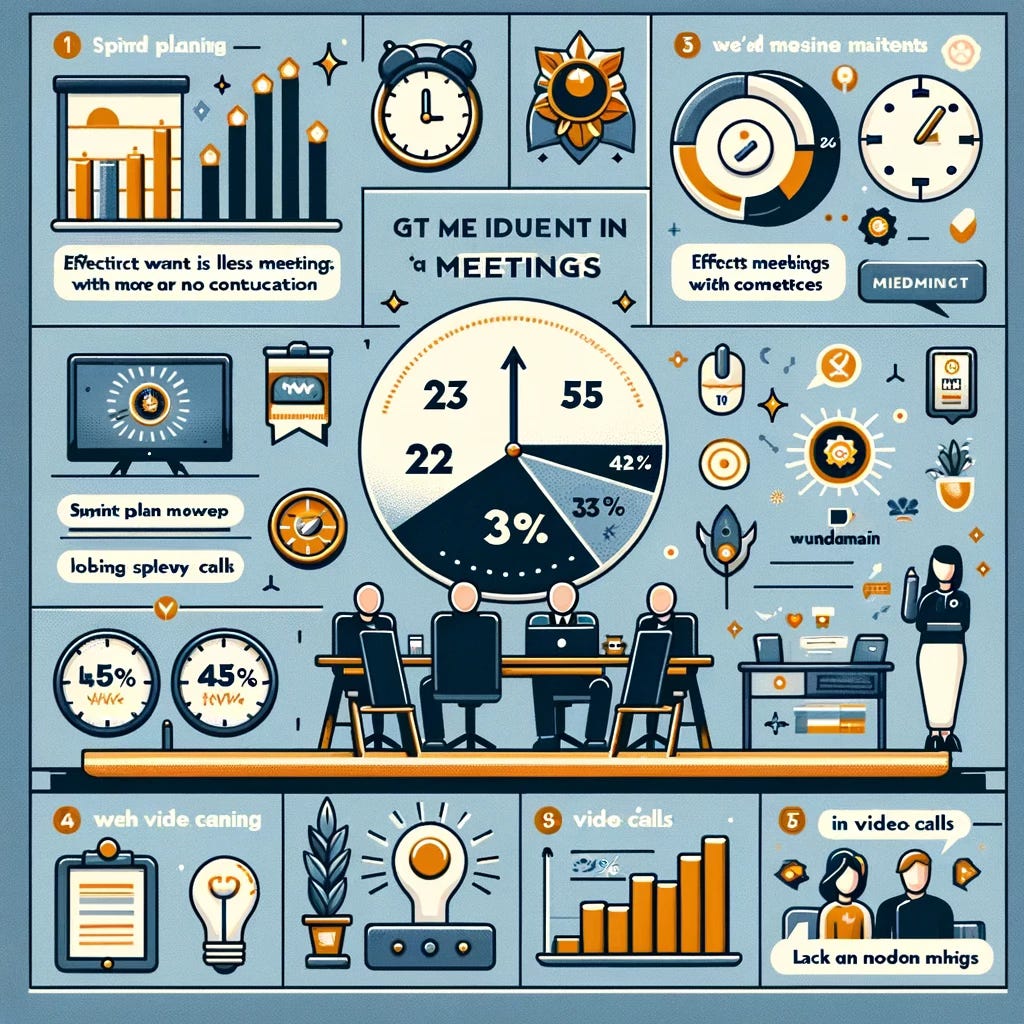The Mirage of Meetings: Navigating the Productivity Paradox in a Hyper-Connected Workplace
Picture a typical morning in the bustling world of tech companies 🌐: Engineers and product managers, armed with fresh ideas and caffeine ☕, are poised to dive into the day's challenges. Their agendas are packed with goals like crafting the next breakthrough feature or debugging a complex code. Yet, as they fire up their laptops 💻, a familiar scenario unfolds: their calendars are crammed with meetings, leaving little room for actual work.
In the high-stakes environment of tech, where innovation and rapid development are key, this meeting-heavy culture often creates an illusion of progress 🔄. But beneath this veneer of constant interaction and collaboration, lies a question: Are these meetings enhancing productivity, or are they an obstacle to the creative and technical work that drives the tech industry forward? 🤔 This article takes a deep dive into the unique meeting culture of tech companies, especially within engineering and product teams, and explores how it impacts the actual productivity and leadership effectiveness in these sectors.
The Meeting Culture in Tech Companies: Engineering and Product Teams
The tech sector, renowned for its fast-paced and innovative nature, has its own unique set of meetings. Engineering and product teams, in particular, face a barrage of stand-ups, sprint planning sessions, code reviews, and product demos. These meetings, while vital for collaboration and alignment, can often spiral into a counterproductive cycle ⏳.
Let’s break it down:
Daily Stand-ups: A staple in agile environments, these quick, daily check-ins are meant to update team members on progress and roadblocks. But when poorly managed, they can drag on, eating into valuable coding or design time ⏰.
Sprint Planning and Retrospectives: Essential for mapping out work in agile sprints, these meetings can become time-consuming marathons if not kept focused and efficient 🏃♂️.
Code Reviews: Critical for maintaining code quality, these sessions can become bottlenecks if they turn into lengthy discussions rather than concise, actionable feedback rounds 🔍.
Product Demos: While showcasing progress is key, overly frequent or poorly prepared demos can lead to presentation fatigue and reduced enthusiasm 📉.
In a survey, tech workers report a significant portion of their week consumed by these meetings. This intensifies in remote and hybrid setups, where digital communication tools have made scheduling meetings easier than ever. But are these meetings truly yielding the productivity dividends they promise?
The Illusion of Productivity
In the tech sector, where every minute counts and innovation is the currency, the overemphasis on meetings can lead to a deceptive illusion of productivity 🎭. The hustle and bustle of back-to-back meetings create a busy atmosphere, but this hustle often obscures the reality: less time for actual work. This relentless meeting marathon can lead to a phenomenon known as 'meeting fatigue', where the act of meeting becomes an end in itself rather than a means to an end.
Wundamail's research sheds light on the underbelly of this trend, particularly in the context of remote meetings. Their findings are revealing:
A mere 56% of participants felt that video calls were a productive use of their time.
42% frequently attended meetings where they had little to no active contribution.
33% reported challenges in focusing during these digital gatherings.
Moreover, the study found that critical information discussed in video calls often evaporated post-meeting, with 42% of workers needing written follow-ups to clarify actions. This suggests that while meetings are meant to be hubs of decision-making and collaboration, they might actually be hindering the retention and effective communication of key information.
The Impact on Work Output and Employee Well-being
The ripple effect of this incessant meeting culture is profound, particularly on work output and employee well-being in tech companies 🌊. When engineers and product managers are tethered to their virtual meeting rooms, their capacity for deep work - that is, work requiring full concentration and critical thinking - is significantly diminished. This constant context-switching can lead to decreased focus, reduced productivity, and, ironically, delays in project timelines.
But the cost isn't just measured in output; it's felt deeply in employee well-being. The stress of juggling endless meetings with actual work deadlines can lead to burnout, a state of emotional, physical, and mental exhaustion. This is particularly concerning in the tech industry, where the pace and pressure are already high. Employee satisfaction and job engagement take a hit, as the joy of creative and analytical work is overshadowed by the dread of another meeting.
The efficacy of written communication, in this context, becomes a beacon of efficiency 📝. When action items and decisions are communicated in writing, not only is there a clear record, but it also allows for asynchronous processing. Team members can digest, reflect, and respond at their own pace, leading to more thoughtful and effective outcomes. This approach not only streamlines the decision-making process but also respects the diverse working styles and needs of individuals in a team.
Proactive Leadership and Time Management
In the dynamic realm of tech, where every second is a sprint towards the next innovation, effective leadership is synonymous with astute time management ⏱️. Proactive leaders in tech companies recognize that an 'empty' calendar isn't a sign of idleness; it's a strategic canvas for creativity, critical thinking, and high-impact work. The key lies in mastering the art of saying 'no' to unnecessary meetings and 'yes' to uninterrupted work periods.
Here are some strategies for tech leaders aiming to optimize their time and foster a culture of productivity:
Evaluate Meeting Necessity: Before scheduling a meeting, leaders should ask, "Could this be resolved via email or a quick message?" If the answer is yes, skip the meeting 🚫.
Limit Meeting Participants: Include only those who are essential to the conversation. This reduces time spent and increases focus for those involved 👥.
Implement 'No Meeting' Blocks: Reserve chunks of time where no meetings are allowed. This ensures periods of undisturbed work, fostering deep thinking and productivity 🧘♂️.
Prioritize Asynchronous Communication: Encourage the use of written communication for updates and decisions, allowing team members to contribute at their own pace 📧.
Delegate Meeting Responsibilities: Not every meeting requires the leader's presence. Delegating meetings to trusted team members can free up significant time while empowering others 🔄.
Case Study: Effective Use of Technology for Productivity
Several tech companies have turned the tide by implementing innovative strategies to cut down on unnecessary meetings and enhance productivity. Here are a few notable examples of my personal approach:
At RKVST: I implemented a department-wide policy of 'Cool-Down Wednesdays', where no internal meetings are scheduled, allowing employees uninterrupted time to focus on project work and personal development 🚀.
At RKVST: We introduced an internal tool that integrates with their calendar system to automatically suggest asynchronous communication options for topics identified as non-urgent or non-critical 🔗.
At THM and RKVST: I developed a 'Meeting Efficiency' playbook, educating employees on how to run more effective, shorter meetings. It also introduced a cultural shift towards valuing written over verbal communication for decision-making 📚.
These examples demonstrate that with thoughtful strategies and a commitment to efficiency, tech companies can harness technology not as a tool for endless meetings, but as a means to foster a more productive, focused, and satisfied workforce.
Conclusion
In the fast-paced, innovation-driven world of tech companies, the key to success is not merely staying busy, but staying smart about how we use our time 🧠. The journey through the labyrinth of meeting culture has revealed a critical insight: effective communication and collaboration, not sheer quantity of interactions, are the true drivers of meaningful decisions and impactful product development. It's about building the right things, for the right people, in the right way.
We've seen how a culture saturated with back-to-back meetings can create an illusion of productivity, while in reality, it often leads to diminished focus, increased stress, and a hinderance to deep, creative work. Proactive leadership and strategic scheduling emerge as powerful tools in breaking this cycle. By prioritizing necessary meetings, fostering a culture of written communication, and reserving time for uninterrupted work, leaders can steer their teams towards more thoughtful, efficient, and ultimately successful outcomes.
As we wrap up this exploration, it's time for a call to action 📢. To the leaders and changemakers in tech: take a moment to reassess your meeting schedules. Ask yourself, "Are these meetings adding value or just filling time?" Embrace the strategies that prioritize effective communication and collaboration. Remember, an empty slot in your calendar is not a gap; it’s an opportunity for focused, high-impact work.
To the individual contributors: advocate for a work environment that respects your time and your need for deep work. Seek clarity in communication and don't hesitate to suggest alternatives to meetings that could be emails or quick chats.
Together, let's shift our focus from running the meeting marathon to crossing the finish line of innovation and success. It's time to transform our workdays from a series of interruptions into a canvas for creativity and progress. Let's not just do more; let's do what's right and do it well 🎯.
References
Wundamail Remote Work Survey (2020).
Harvard Business Review: Various articles on Meeting Culture.





